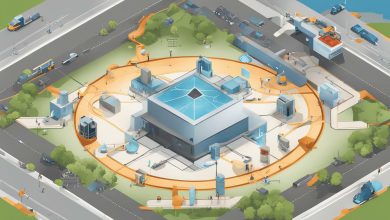In today’s rapidly evolving software development industry, it’s essential to have efficient and streamlined processes in place for continuous delivery of microservices. This is where Azure DevOps, along with .NET Core and C#, comes into play. With the right toolkit and expertise, you can effortlessly implement a continuous delivery pipeline that helps you stay ahead of the competition and deliver high-quality software at scale.
In this article, we’ll take a deep dive into the world of continuous delivery of microservices and explore how Azure DevOps, .NET Core, and C# can help you achieve your goals. We’ll cover everything from the basics of Azure DevOps and its role in continuous delivery to the specifics of microservices development using .NET Core and C#. By the end of this article, you’ll have a clear understanding of how to leverage Azure DevOps and related technologies to streamline your software development process and deliver high-quality code at scale.
Key Takeaways:
- Efficient and streamlined processes are essential for continuous delivery of microservices in software development.
- Azure DevOps, .NET Core, and C# offer a powerful toolkit for implementing a continuous delivery pipeline.
- With the right expertise, it’s possible to leverage Azure DevOps and related technologies to streamline your software development process and deliver high-quality code at scale.
Understanding Azure DevOps and its Role in Continuous Delivery
For developers looking to enhance their software development, Azure DevOps tools are worth considering. Azure DevOps provides developers with an integrated set of tools to manage the entire DevOps pipeline, from coding to deployment. By leveraging Azure DevOps, developers can improve DevOps practices, streamline code management, and improve software development workflows.
Continuous delivery is an integral part of modern software development, and Azure DevOps plays an essential role in achieving this. With Azure DevOps, developers can create an efficient and robust CI/CD pipeline that automates the development process, ensuring faster and more reliable software deployment.
DevOps practices, such as continuous integration and delivery, are becoming increasingly important, and Azure DevOps makes it easier to achieve these goals. With Azure DevOps, DevOps practices can be implemented throughout the entire software development lifecycle. This ensures a more collaborative and efficient workflow, where developers, QA, and operations work together more closely.
Setting up a CI/CD pipeline is one of the significant benefits of using Azure DevOps. It allows developers to automate the build, testing, and deployment processes, ultimately delivering software more efficiently. Creating a robust CI/CD pipeline is crucial for automating these processes, and Azure DevOps provides the tools needed to accomplish this.
Leveraging .NET Core and C# for Microservices Development
Microservices are becoming increasingly popular in modern software development, and .NET Core and C# offer a powerful platform for their creation. .NET Core is a versatile open-source framework that can be used to build microservices for Windows, macOS, and Linux. C# is an expressive language that enables developers to develop distributed systems with ease.
One of the significant advantages of microservices is their ability to form distributed systems. These systems are made up of interconnected services, and .NET Core and C# offer a simple approach to their development. The architecture of the microservices built with .NET Core and C# allows them to communicate seamlessly with one another, allowing for scalable and efficient software systems.
Another advantage of using .NET Core and C# for microservices development is containerization. Containerization enables developers to package applications with all their dependencies into a single container. The container can then be moved between environments such as development, testing, and production, making it easier to deploy microservices across various stages of the CI/CD pipeline. Containers make it possible to deploy microservices with all their dependencies, ensuring that they work consistently across all environments.
.NET Core and C# offer a robust platform for the development of microservices, providing a versatile framework, expressive language, and containerization capabilities. These technologies allow for the creation of scalable, efficient distributed systems, ideal for modern software development.
Implementing Continuous Delivery in Azure DevOps with .NET Core and C#
Continuous delivery is a crucial aspect of modern software development. Azure DevOps, along with .NET Core and C#, offers a powerful platform for achieving efficient and streamlined software delivery processes. In this section, we will provide step-by-step guidance on implementing continuous delivery of microservices in Azure DevOps using .NET Core and C#.
Setting up Azure Services
The first step is to set up Azure services for our project. This can be done using the Azure portal or via Azure CLI. We can choose from a variety of services such as Azure Kubernetes Service (AKS), Azure Container Instances (ACI), or Azure App Service.
Creating a CI/CD Pipeline
The next step is to create a CI/CD pipeline. This can be done by selecting the Azure DevOps project and creating a new pipeline. We can choose from a variety of options such as YAML or classic editor. We need to define the build and release stages and configure the deployment targets.
Managing Software Deployment
Once the pipeline is set up, we can manage software deployment using Azure DevOps. This includes managing artifacts, defining deployment strategies, and configuring the release gates. We can also set up automated testing and approvals to ensure that the software is of high quality and meets all the necessary requirements.
Effective Release Management Strategies
Effective release management strategies are crucial for ensuring successful software delivery. We can use Azure DevOps to manage release gates, track release progress, and address any issues that arise during the release process. We can also use Azure DevOps Insights to gain insights into release trends and identify areas for improvement.
Conclusion
Implementing continuous delivery in Azure DevOps with .NET Core and C# offers numerous benefits for modern software development. By leveraging Azure services, creating a CI/CD pipeline, managing software deployment, and implementing effective release management strategies, we can streamline our software delivery processes and ensure high-quality software delivery.
Conclusion
In conclusion, the continuous delivery of microservices has become an essential practice in modern software development. Azure DevOps, equipped with powerful tools such as .NET Core and C#, can help developers achieve efficient and streamlined continuous delivery processes.
Throughout this article, we explored the functionalities of Azure DevOps and its significance in continuous delivery. We also discussed the role of .NET Core and C# in developing microservices and how containerization can benefit microservice deployment.
Furthermore, we provided step-by-step guidance on implementing continuous delivery of microservices in Azure DevOps using .NET Core and C#. This included the integration of Azure services, setting up a CI/CD pipeline, managing software deployment, and effective release management strategies.
Revolutionizing Software Productivity
By utilizing Azure DevOps, .NET Core, and C#, developers can master the continuous delivery of microservices in a streamlined and efficient manner. This approach can revolutionize software productivity, ensuring that products are delivered faster and with the highest quality standards.
Overall, it is clear that continuous delivery is essential in modern software development, and Azure DevOps equipped with .NET Core and C# can help developers achieve efficient and streamlined continuous delivery processes that will catapult software engineering into the future.
FAQ
Q: What is continuous delivery of microservices?
A: Continuous delivery of microservices is a software development approach that focuses on delivering small, independent and loosely coupled services, enabling rapid and frequent deployment of new features and updates.
Q: Why is continuous delivery important in modern software development?
A: Continuous delivery allows for faster time-to-market, increased software quality, and improved collaboration between development and operations teams. It enables organizations to respond quickly to changing customer requirements and market demands.
Q: How does Azure DevOps support continuous delivery?
A: Azure DevOps provides a comprehensive set of tools and services that facilitate the entire software development lifecycle, including continuous integration and continuous delivery (CI/CD) pipelines. It offers features like automated build, deployment, testing, and release management.
Q: What role does .NET Core play in microservices development?
A: .NET Core is a cross-platform framework that enables the development of scalable and high-performance microservices. It provides a rich set of libraries and tools for building and deploying microservices in various environments.
Q: How can C# be leveraged in microservices development?
A: C# is a powerful and expressive programming language that is widely used for building distributed systems, including microservices. It offers features like strong typing, asynchronous programming, and extensive support for object-oriented programming.
Q: What are the benefits of containerization in microservice deployment?
A: Containerization allows for easy packaging and deployment of microservices, providing isolation, scalability, and portability. Containers enable efficient resource utilization and simplify the management of complex microservice architectures.
Q: How can I set up a CI/CD pipeline using Azure DevOps, .NET Core, and C#?
A: Setting up a CI/CD pipeline involves configuring build and release pipelines in Azure DevOps, integrating version control, automated testing, and deployment. This process ensures that your application is built, tested, and deployed automatically whenever changes are made.
Q: What Azure services can be integrated with Azure DevOps for continuous delivery?
A: Azure DevOps integrates seamlessly with various Azure services, such as Azure Container Registry, Azure Kubernetes Service, Azure Functions, and Azure App Service. These services provide additional capabilities for deploying and managing microservices in the cloud.
Q: How can I effectively manage software deployment and release using Azure DevOps?
A: Azure DevOps offers release management features that enable you to define and automate release pipelines, including approvals, environment configurations, and deployment strategies. This enables smooth and controlled software deployment to different environments.








